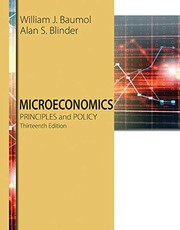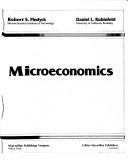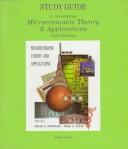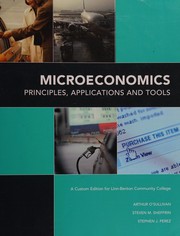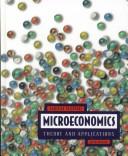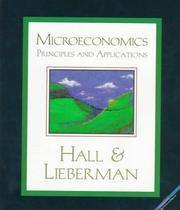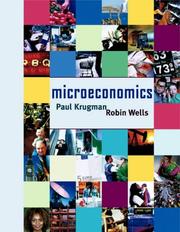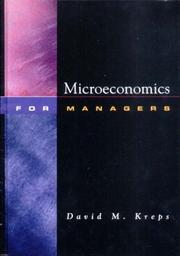Are you looking to expand your knowledge of microeconomics? Look no further! We’ve compiled a list of the 20 best books about microeconomics that are sure to engage and enlighten any reader. Whether you’re a student, a professional, or simply interested in the subject, these books offer valuable insights into the principles and practices of microeconomics. From classic texts to modern interpretations, each book on microeconomics is carefully selected to provide a comprehensive understanding of the field. So, dive into the world of microeconomics with these top-notch microeconomics books and broaden your understanding of this fascinating subject.
Contents
- 1 20 Best Microeconomics Books
- 2 Microeconomics: Principles and Policy
- 3 Microeconomics: Theory and Applications with Calculus
- 4 Microeconomics
- 5 Microeconomics: A Modern Approach
- 6 Microeconomics: Theory and Applications
- 7 Microeconomics: Private and Public Choice
- 8 Microeconomics: Principles, Applications, and Tools
- 9 Microeconomics: Behavior, Institutions, and Evolution
- 10 Microeconomics: An Intuitive Approach with Calculus
- 11 Microeconomics: Theory and Applications
- 12 Microeconomics: Principles and Applications
- 13 Microeconomics: Theory and Applications
- 14 Principles of Microeconomics
- 15 Microeconomics
- 16 Intermediate Microeconomics: A Modern Approach
- 17 Microeconomics
- 18 Microeconomics
- 19 Microeconomics for Managers
- 20 Microeconomic Analysis
- 21 Microeconomics: Private and Public Choice
- 22 Final Thoughts on Best Microeconomics Books
- 23
20 Best Microeconomics Books
Microeconomics: Principles and Policy
by William J. Baumol and Alan S. Blinder
Microeconomics: Principles and Policy by William J. Baumol and Alan S. Blinder is a comprehensive book on microeconomics that delves into the principles and policies that govern individual economic decisions. The authors provide a clear and engaging overview of the fundamental concepts of microeconomics, offering a deep understanding of how individuals and businesses make choices in the allocation of resources.
Readers will find themselves immersed in a world of supply and demand, consumer behavior, market structures, and the role of government in the economy. Baumol and Blinder present real-world examples and case studies to illustrate the application of microeconomic principles, making the subject matter easily accessible and relatable.
Whether you are a student looking to grasp the intricacies of microeconomics or a curious individual seeking to expand your knowledge of economics, this book about microeconomics will undoubtedly provide valuable insights and a solid foundation in the subject. With its accessible language and comprehensive coverage, Microeconomics: Principles and Policy is a must-read for anyone interested in understanding the dynamics of individual decision-making within the economy.
Microeconomics: Theory and Applications with Calculus
by Jeffrey M. Perloff
Microeconomics: Theory and Applications with Calculus by Jeffrey M. Perloff is a comprehensive and engaging book on microeconomics that delves into the fundamental concepts and principles of the field. With a focus on real-world applications and examples, Perloff’s book provides a thorough understanding of microeconomic theory using calculus. This book about microeconomics covers a wide range of topics including consumer theory, production and cost, perfect competition, monopoly, and game theory.
What sets this microeconomics book apart is its integration of calculus to analyze and solve complex economic problems, making it an invaluable resource for students and practitioners looking to deepen their understanding of microeconomic theory. Perloff’s clear and accessible writing style, coupled with numerous illustrative examples and exercises, makes the subject of microeconomics come to life, making it an essential read for anyone interested in delving deeper into the world of microeconomics.
Microeconomics
by Robert S. Pindyck and Daniel L. Rubinfeld
Microeconomics by Robert S. Pindyck and Daniel L. Rubinfeld is a comprehensive and accessible book on the principles of microeconomics. This widely acclaimed textbook provides a clear and engaging introduction to the study of individual economic units, such as households and firms, and their interactions in the market. The authors skillfully blend theory and real-world examples to help readers understand the fundamental concepts of microeconomics and their applications in various economic situations.
Readers can expect to delve into topics such as supply and demand, consumer behavior, production and cost theory, market structures, and the role of government in the economy. The book also emphasizes the importance of economic analysis in decision-making and policy formulation. Whether you are a student seeking a solid foundation in microeconomics or a curious reader eager to understand the workings of markets, this book about microeconomics is an invaluable resource for gaining a deeper understanding of economic principles and their impact on our daily lives.
Microeconomics: A Modern Approach
by Andrew Schotter
Microeconomics: A Modern Approach by Andrew Schotter is an engaging and comprehensive book on microeconomics that provides a fresh perspective on the subject. Schotter takes a modern approach to the study of individual economic units and their behavior in the market. The book covers a wide range of topics, including supply and demand, consumer behavior, production and costs, market structures, and the role of government in the economy.
What sets this microeconomics book apart is its focus on real-world applications and its use of modern examples to illustrate key concepts. Schotter’s clear and accessible writing style makes complex economic theories easy to understand, making it an ideal choice for students and anyone interested in gaining a solid understanding of microeconomics. Whether you’re a beginner or have some prior knowledge of the subject, Microeconomics: A Modern Approach is a valuable resource that will deepen your understanding of the economic forces that shape our world.
Microeconomics: Theory and Applications
by Edgar K. Browning and Mark A. Zupan
Looking for a comprehensive book on microeconomics that brings the theory to life with real-world applications? Look no further than Microeconomics: Theory and Applications by Edgar K. Browning and Mark A. Zupan. This engaging and accessible text provides a thorough exploration of the principles of microeconomics and their relevance to everyday life.
The authors take a practical approach to the subject, using examples from various industries and markets to illustrate key concepts. Readers will gain a deeper understanding of consumer behavior, market structures, and the role of government in the economy. The book also delves into the implications of microeconomic theory for public policy and business strategy, making it a valuable resource for students and professionals alike.
Whether you’re new to the field or looking to deepen your knowledge, this microeconomics book offers a comprehensive foundation in the subject, with clear explanations, engaging examples, and thought-provoking applications. Get ready to see the world through an economic lens with Microeconomics: Theory and Applications.
Microeconomics: Private and Public Choice
by James D. Gwartney, Richard L. Stroup, and Russell S. Sobel
This is a fantastic book on microeconomics that delves into the fascinating world of economic decision-making. In “Microeconomics: Private and Public Choice” by James D. Gwartney, Richard L. Stroup, and Russell S. Sobel, readers are taken on a journey through the principles of microeconomics, exploring how individuals, businesses, and governments make choices in the allocation of resources. The authors skillfully blend real-world examples with economic theory to provide a comprehensive understanding of the subject.
What sets this microeconomics book apart is its focus on both private and public decision-making. Readers will gain insight into how markets work, as well as the role of government in influencing economic outcomes. The book also offers a critical analysis of various economic policies, making it relevant for understanding contemporary economic issues.
Whether you’re a student seeking a solid foundation in microeconomics or a curious reader interested in the workings of the economy, “Microeconomics: Private and Public Choice” is an engaging and informative read that will leave you with a deeper appreciation for the complexities of economic decision-making.
Microeconomics: Principles, Applications, and Tools
by Arthur O’Sullivan, Steven Sheffrin, and Stephen Perez
Looking for a comprehensive book about microeconomics that is both informative and engaging? Look no further than “Microeconomics: Principles, Applications, and Tools” by Arthur O’Sullivan, Steven Sheffrin, and Stephen Perez. This book is a must-read for anyone interested in understanding the fundamental concepts and principles of economics at the micro level.
The authors take a practical approach to microeconomics by providing real-world examples and applications that help readers understand how economic principles play out in everyday life. The book covers essential topics such as supply and demand, consumer behavior, production and cost, and market structures, providing readers with a solid foundation in microeconomics.
What sets this microeconomics book apart is its emphasis on tools and applications, making it a valuable resource for students and professionals alike. Whether you’re studying economics for the first time or looking to deepen your understanding of microeconomics, this book is an essential addition to your library.
Microeconomics: Behavior, Institutions, and Evolution
by Samuel Bowles
Microeconomics: Behavior, Institutions, and Evolution by Samuel Bowles is an illuminating book on the study of individual economic behavior within the framework of institutions and evolutionary processes. Bowles explores the intricate interplay between human behavior, societal institutions, and the evolutionary forces that shape economic outcomes.
This thought-provoking book about microeconomics delves into the behavioral aspects of decision-making, the role of social and economic institutions in shaping individual choices, and the ways in which these behaviors and institutions evolve over time. Bowles presents a compelling argument for understanding microeconomics as a dynamic and adaptive system, rather than a static set of principles.
Through a captivating blend of theory, empirical evidence, and real-world examples, Bowles offers a fresh perspective on the complexities of microeconomic processes. Whether you’re a student, an academic, or a curious reader interested in understanding the intricacies of economic behavior, this microeconomics book is sure to expand your knowledge and challenge your assumptions about how individuals, institutions, and evolution interact in the economic sphere.
Microeconomics: An Intuitive Approach with Calculus
by Thomas J. Nechyba
Are you looking for an engaging and intuitive book on microeconomics that incorporates calculus? Look no further than “Microeconomics: An Intuitive Approach with Calculus” by Thomas J. Nechyba. This book offers a fresh perspective on the study of economics, providing readers with a comprehensive understanding of economic theory and its practical applications.
Nechyba’s approach to the subject is both accessible and rigorous, making complex economic concepts easy to grasp for readers with a range of mathematical backgrounds. By integrating calculus into the discussion, this book about microeconomics delves into the mathematical underpinnings of economic principles, offering a deeper understanding of how these concepts are derived and applied in real-world scenarios.
Whether you’re a student, an academic, or simply someone with a keen interest in economics, “Microeconomics: An Intuitive Approach with Calculus” is a must-read for anyone looking to gain a comprehensive understanding of this fascinating and essential field of study. Get ready to expand your knowledge and develop a new appreciation for the intricacies of microeconomics with this insightful microeconomics book.
Microeconomics: Theory and Applications
by Dominick Salvatore
Microeconomics: Theory and Applications by Dominick Salvatore is a comprehensive and insightful book on the principles of individual economic behavior. This book about microeconomics delves into the theories and applications of how individuals and firms make decisions and interact in the marketplace. Salvatore provides a clear and engaging analysis of the fundamental concepts of microeconomics, making it an essential read for students, professionals, and anyone interested in understanding the intricate workings of the economy at the micro level.
With a focus on real-world examples and practical applications, this microeconomics book offers a deep understanding of consumer behavior, market structures, pricing strategies, and the role of government intervention. Salvatore’s accessible writing style and structured approach make this book on microeconomics a valuable resource for grasping complex economic concepts and their relevance in everyday life. Whether you’re new to the subject or looking to deepen your understanding, Microeconomics: Theory and Applications is a must-read for anyone interested in the dynamics of individual economic decision-making.
Microeconomics: Principles and Applications
by Robert E. Hall and Marc Lieberman
Are you ready to dive into the world of microeconomics? Look no further than Microeconomics: Principles and Applications by Robert E. Hall and Marc Lieberman. This comprehensive book on microeconomics is designed to provide a thorough understanding of the principles and applications of microeconomics. The authors take a practical approach to the subject, using real-world examples and case studies to illustrate key concepts and theories.
Whether you’re a student studying economics for the first time or a business professional looking to refresh your understanding of microeconomics, this book about microeconomics has something to offer. From supply and demand to market structures and efficiency, Hall and Lieberman cover all the essential topics in an accessible and engaging manner.
With its clear explanations, insightful examples, and helpful study tools, Microeconomics: Principles and Applications is a must-read for anyone looking to grasp the fundamentals of microeconomics. Get ready to expand your knowledge and gain a deeper understanding of economic decision-making with this top-notch microeconomics book.
Microeconomics: Theory and Applications
by Jeffrey M. Perloff
Microeconomics: Theory and Applications by Jeffrey M. Perloff is a comprehensive and engaging book on microeconomics that provides a thorough understanding of the principles and practical applications of economic theory at the individual and firm level. Perloff’s clear and concise writing style, combined with real-world examples and case studies, makes this book about microeconomics an essential resource for students and professionals alike.
Readers will gain insight into consumer behavior, production, market structures, and the impact of government policies on microeconomic decision-making. The book on microeconomics also explores the role of information, uncertainty, and game theory in shaping economic outcomes. Perloff’s emphasis on the relevance of microeconomic theory in everyday life and business makes this microeconomics book a valuable resource for anyone seeking to understand the fundamentals of economic analysis.
Principles of Microeconomics
by N. Gregory Mankiw
Principles of Microeconomics by N. Gregory Mankiw is a renowned book on the fundamental principles of economics at the micro level. This book about microeconomics provides a clear and concise introduction to the economic concepts that form the basis of decision-making at the individual and firm level. Mankiw’s engaging writing style and real-world examples make complex economic theories accessible and relevant to readers.
The book covers a wide range of topics, including supply and demand, consumer behavior, production and costs, market structures, and the role of government in the economy. Mankiw’s emphasis on the practical application of economic principles and his incorporation of current events and data make this microeconomics book an essential read for students and anyone interested in understanding how individuals and businesses make economic decisions in the real world.
Microeconomics
by Robert S. Pindyck
Microeconomics by Robert S. Pindyck is an insightful exploration of the fundamental principles and theories that drive the behavior of individual economic agents, such as consumers and firms. This engaging book on microeconomics delves into the intricate workings of markets and how they allocate resources efficiently. Pindyck presents a comprehensive analysis of supply and demand, production and cost, market structures, and the impact of government intervention on the economy.
Readers will find this book about microeconomics to be a valuable resource for understanding the complexities of decision-making at the micro level, whether it’s the choices made by a single consumer or the pricing strategies of a firm. Pindyck’s clear and concise explanations, along with real-world examples, make this microeconomics book an essential read for anyone seeking a deeper understanding of how individuals and businesses make economic decisions in a constantly changing environment. Whether you’re a student, professional, or curious mind, Microeconomics offers a compelling exploration of the forces that shape our everyday economic interactions.
Intermediate Microeconomics: A Modern Approach
by Hal R. Varian
Hal R. Varian’s Intermediate Microeconomics: A Modern Approach is a comprehensive and engaging book on microeconomics that bridges the gap between theory and real-world application. Varian, an esteemed economist and professor, presents complex economic concepts in a clear and accessible manner, making it an ideal resource for students and professionals alike.
This microeconomics book covers a wide range of topics, including consumer choice, production and cost analysis, market structure, game theory, and welfare economics. Varian’s modern approach incorporates the latest research and developments in the field, ensuring that readers are equipped with the most up-to-date knowledge and tools for economic analysis.
Furthermore, the book is filled with practical examples, thought-provoking exercises, and insightful case studies that encourage critical thinking and application of economic principles to real-world scenarios. Whether you’re a student looking to deepen your understanding of microeconomics or a professional seeking to enhance your analytical skills, Intermediate Microeconomics: A Modern Approach is an invaluable resource that will enrich your knowledge and perspective on economic theory and practice.
Microeconomics
by Paul Krugman
Microeconomics by Paul Krugman is a renowned book on the study of individual economic units and their interactions in the market. This insightful and engaging book about microeconomics covers a wide range of topics, from supply and demand to consumer behavior and market structures. Krugman’s clear and concise writing style makes complex economic concepts accessible and easy to understand for readers of all levels. With real-world examples and applications, this microeconomics book provides a comprehensive understanding of how individuals and firms make decisions and interact in the marketplace.
Microeconomics
by David Besanko
Microeconomics by David Besanko is a comprehensive and insightful book on the fundamental principles of the economic behavior of individuals, firms, and markets. This book about microeconomics provides a clear and engaging overview of the concepts and theories that form the foundation of microeconomic analysis.
Besanko’s book on microeconomics delves into topics such as supply and demand, consumer behavior, production and cost, market structures, and the role of government in the economy. With its practical examples and real-world applications, the book offers readers a deep understanding of how microeconomic principles shape decision-making and resource allocation in various economic settings.
Whether you are a student looking to grasp the essentials of microeconomics or a professional seeking to enhance your understanding of market dynamics, this microeconomics book is a valuable resource. Its clear explanations and thought-provoking insights make it an essential read for anyone interested in delving into the intricate workings of the economic choices we make every day.
Microeconomics for Managers
by David M. Kreps
Microeconomics for Managers by David M. Kreps is a valuable resource for anyone looking to understand the intricacies of managing in the world of business. This book on microeconomics provides a comprehensive overview of the fundamental concepts of microeconomics and how they apply to managerial decision-making. Kreps delves into topics such as supply and demand, pricing strategies, cost analysis, and market structures, all with a focus on how managers can use these concepts to make informed and effective business decisions.
Readers will appreciate Kreps’ clear and concise writing style, making complex economic principles accessible and applicable to real-world scenarios. Whether you’re a seasoned business professional or a budding entrepreneur, this microeconomics book is a must-read for anyone looking to gain a deeper understanding of the economic forces at play in the business world. Kreps’ insights and practical examples make this book about microeconomics an essential addition to any manager’s library.
Microeconomic Analysis
by Hal R. Varian
Microeconomic Analysis by Hal R. Varian is a classic book on microeconomics that provides a comprehensive and insightful exploration of the subject. Varian’s clear and engaging writing style makes complex economic concepts accessible to readers of all levels of expertise. The book covers a wide range of topics, including consumer behavior, production theory, market structure, and general equilibrium. Varian also incorporates real-world examples and applications to illustrate how microeconomic principles are used in practice.
This microeconomics book is a valuable resource for students, educators, and anyone interested in gaining a deeper understanding of how individuals and firms make economic decisions in various market settings. Varian’s emphasis on analytical rigor and practical relevance makes Microeconomic Analysis an essential addition to the library of anyone interested in the field of economics. Whether you are a student seeking to grasp the fundamentals of microeconomics or a professional looking to expand your knowledge, this book about microeconomics is a must-read.
Microeconomics: Private and Public Choice
by James D. Gwartney
Microeconomics: Private and Public Choice by James D. Gwartney is a comprehensive book on the principles of individual decision-making and how it influences both private and public economic choices. This book about microeconomics delves into the intricate workings of markets, consumer behavior, and the role of government in the economy.
Gwartney’s writing style makes this microeconomics book accessible and engaging for readers of all levels of expertise in the subject. The book provides insights into the economic forces that shape our everyday lives, from the prices we pay for goods and services to the policies that impact our communities.
Whether you are a student looking to grasp the fundamentals of microeconomics or a curious reader interested in understanding the economic forces at play in the world, Microeconomics: Private and Public Choice offers a wealth of knowledge and real-world examples to help you navigate the complexities of economic decision-making.
Final Thoughts on Best Microeconomics Books
Exploring the world of Microeconomics through these 20 best books about microeconomics is a fascinating journey. Whether you are a student, professional, or simply curious about the subject, these books offer valuable insights and knowledge that can help you understand the intricate workings of markets, consumer behavior, and decision-making. From classic texts to modern interpretations, there is something for everyone looking to delve deeper into the world of microeconomics.
Which book about Microeconomics is best?
The best book on Microeconomics can vary with personal preference, but three widely recommended titles are:
- Microeconomics: Principles and Policy by William J. Baumol and Alan S. Blinder,
- Microeconomics: Theory and Applications with Calculus by Jeffrey M. Perloff,
- Microeconomics by Robert S. Pindyck and Daniel L. Rubinfeld.
Each offers valuable insights and could be a great starting point.
What are the best books to learn about Microeconomics?
For those looking to learn about Microeconomics, there is a wealth of literature that can provide a comprehensive understanding of the subject. Some of the most highly recommended books include:
- Microeconomics: Principles and Policy by William J. Baumol and Alan S. Blinder,
- Microeconomics: Theory and Applications with Calculus by Jeffrey M. Perloff,
- Microeconomics by Robert S. Pindyck and Daniel L. Rubinfeld,
- Microeconomics: A Modern Approach by Andrew Schotter,
- Microeconomics: Theory and Applications by Edgar K. Browning and Mark A. Zupan,
- Microeconomics: Private and Public Choice by James D. Gwartney, Richard L. Stroup, and Russell S. Sobel,
- Microeconomics: Principles, Applications, and Tools by Arthur O’Sullivan, Steven Sheffrin, and Stephen Perez,
- Microeconomics: Behavior, Institutions, and Evolution by Samuel Bowles,
- Microeconomics: An Intuitive Approach with Calculus by Thomas J. Nechyba,
- Microeconomics: Theory and Applications by Dominick Salvatore
These books offer a range of perspectives on Microeconomics, covering various aspects and approaches to the subject.
What are the best books about Microeconomics?
The best books about Microeconomics are:
- Microeconomics: Principles and Policy by William J. Baumol and Alan S. Blinder,
- Microeconomics: Theory and Applications with Calculus by Jeffrey M. Perloff,
- Microeconomics: Principles and Applications by Robert E. Hall and Marc Lieberman,
- Microeconomics: Theory and Applications by Jeffrey M. Perloff,
- Microeconomics: Behavior, Institutions, and Evolution by Samuel Bowles,
- Microeconomics: Private and Public Choice by James D. Gwartney, Richard L. Stroup, and Russell S. Sobel.
Each offers unique insights into the subject. While these books about Microeconomics are highly regarded, it’s important to note that any list of ‘best’ books is subjective and reflects a range of opinions.
What are the best Microeconomics books of all time?
Choosing the best Microeconomics books of all time can vary depending on who you ask, but five titles that are often celebrated include
- Microeconomics: Principles and Policy by William J. Baumol and Alan S. Blinder,
- Microeconomics: Theory and Applications with Calculus by Jeffrey M. Perloff,
- Microeconomics: Theory and Applications by Edgar K. Browning and Mark A. Zupan,
- Microeconomics: Behavior, Institutions, and Evolution by Samuel Bowles,
- and Microeconomics: Principles and Applications by Robert E. Hall and Marc Lieberman.
Each of these books has made a significant impact in the field of Microeconomics and continues to be influential today.

